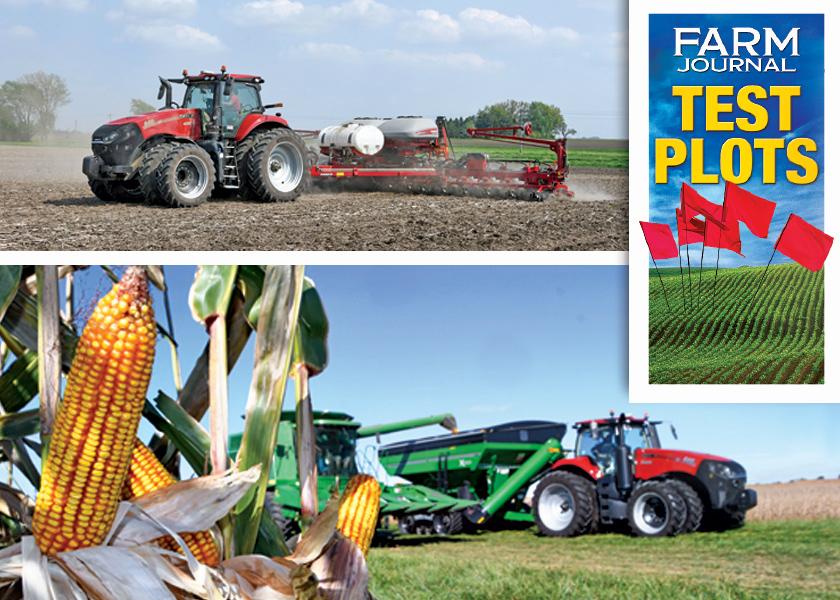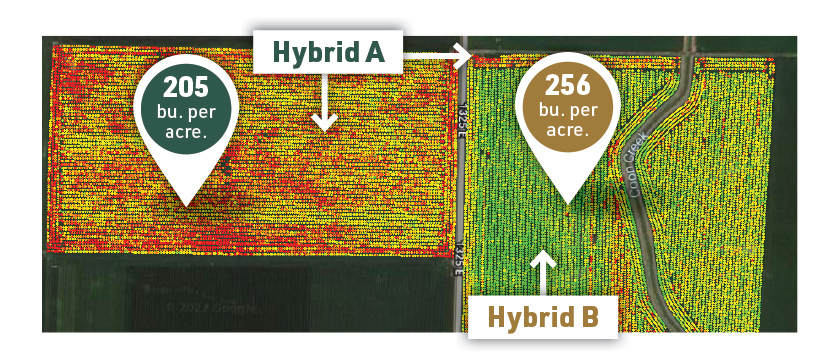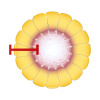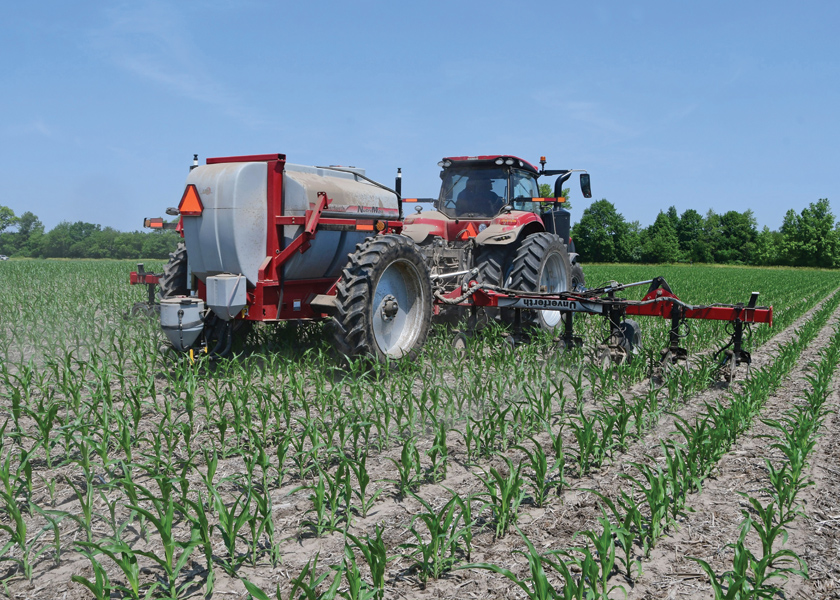Is the Weather Or Your Hybrid Management to Blame This Season?

Some of you might be disappointed by the yields of your favorite hybrids this fall. But don’t be too quick to cast them out of your lineup. It might be the weather’s fault — a dry June throughout much of the Corn Belt — rather than the hybrid.
Data from a Farm Journal Test Plot study, which has been underway for a decade, not only reveals the impact of weather but lets farmers adjust practices to maximize the yield of each hybrid they grow.
Stress Response
As for this year’s yield, Ken Ferrie, Farm Journal field agronomist, references 2022, which also experienced a dry June in many areas.

“Our farmer-clients were phoning from their combines, reporting proven hybrids coming up 20 bu. to 50 bu. per acre short compared with other hybrids in the same field,” he says. “After harvest we saw the same thing on other clients’ yield maps.
“The low-yielding hybrids were those that flex ear length downward in response to stress from emergence to tasseling,” Ferrie continues. “The ears were well-filled, but they were only 33 to 34 kernels long. We used to say if a hybrid was rolling during the day but still growing at night, the stress probably was not that harmful. But we now know that’s not true for this class of hybrids. I think we’ll see the same situation this year, even if we had good moisture from pollination through the end of the growing season.”
The Farm Journal study has shown all hybrids flex ear size in response to stress — but only downward, never upward, so you never regain lost yield.
“That’s why we say never let corn have a bad day,” Ferrie says. “The differing flex responses result from plant traits, such as height and leaf structure (upright or pendulum), size (narrow leaves versus wide) and the flex characteristics of each hybrid.”
Further, various hybrids are affected by stress at different times during the growing season.
“You can’t change the weather,” Ferrie says. “But if you know when each hybrid is most susceptible to stress, such as from emergence to tasseling versus late in the growing season, you can adjust your practices to manage around that weakness. If you can’t change your practices, such as adding starter fertilizer to your planter or applying fungicides, choose a different hybrid that responds to your style of management.”
Another example of stress response occurred in 2012, Ferrie adds. Drought after tasseling hammered hybrids most affected by stress late in the growing season, especially those with upright leaf structure that couldn’t protect themselves from the heat.
“Pendulum-leaf hybrids that year often had higher yields by as much as 50 bu. to 100 bu. per acre,” he says.
Thanks to the Farm Journal research, seed companies, such as plot partners AgriGold and Wyffels Hybrids, now include information about plant characteristics, including height, leaf structure and response to population, nitrogen timing and fungicides, in their seed catalogs. Using that information, you can select the best hybrids for your fields and manage them to maximize yield.
Why Your Favorite Hybrid Could Fizzle This Fall
These yield maps from 2022 illustrate what can happen when a hybrid that flexes its ears early in the growing season suffers stress from emergence to the VT (tassel) growth stage. In this case, the yield loss was caused by drought in June — very similar to the weather in 2023.

 The operator of the fields above thought his sidedress operator missed the field at left. Planted to Hybrid A , it flexes ear length early in the season. But switching to Hybrid B after planting the headland in the field at right revealed that Hybrid A yielded 51 bu. per acre less due to drought stress in June. Hybrid B was not affected by the early drought because it flexes depth of kernel (rather than ear length) late in the growing season.
The operator of the fields above thought his sidedress operator missed the field at left. Planted to Hybrid A , it flexes ear length early in the season. But switching to Hybrid B after planting the headland in the field at right revealed that Hybrid A yielded 51 bu. per acre less due to drought stress in June. Hybrid B was not affected by the early drought because it flexes depth of kernel (rather than ear length) late in the growing season.
This map shows similar situations, in which an early-flexing hybrid (Hybrid D) yielded significantly less than a later- flexing hybrid (Hybrid C). While you can’t change the weather, knowing the ear-flex characteristics of your hybrids will enable you to eliminate fertility and disease stress during critical ear-flex periods by timely sidedressing and fungicide applications.
What the Study Has Revealed
Farm Journal Field Agronomist Ken Ferrie’s interest in plant characteristics grew out of analyzing thousands of yield maps every autumn for his farmer clients. “The yield maps showed many factors cause the yield of a hybrid to vary from one farmer to the next,” he says. “But the top two factors, far above the others, are water management (including soil compaction, irrigation, population and plant characteristics) and hybrid selection. So we launched our study.”
Early on, the study revealed all hybrids flex, or adjust their ear size, but not in the same way. Ferrie divides hybrids as:

 G hybrids: A G rating, for girth, means the plant changes the number of rows around the cob. “G hybrids flex girth early in the season,” Ferrie says, “from emergence to the V6 or V7 stage. We need to protect them from early stress.” A G hybrid will respond to good planting conditions and up-front nitrogen. It will disappoint in cold soil with no starter fertilizer.
G hybrids: A G rating, for girth, means the plant changes the number of rows around the cob. “G hybrids flex girth early in the season,” Ferrie says, “from emergence to the V6 or V7 stage. We need to protect them from early stress.” A G hybrid will respond to good planting conditions and up-front nitrogen. It will disappoint in cold soil with no starter fertilizer.
 L hybrids: L hybrids adjust ear length. “We break this group into two sectors,” Ferrie says. “L1 hybrids flex in length before tasseling, maybe from 42 kernels down to 34 or 35. With enough stress during that period, they will abort cob and all. It will look like good ear-fill but the ear is only 33 or 34 kernels long. L1 hybrids don’t like stress during the rapid-growth stage, from V8 to VT (tassel).”
L hybrids: L hybrids adjust ear length. “We break this group into two sectors,” Ferrie says. “L1 hybrids flex in length before tasseling, maybe from 42 kernels down to 34 or 35. With enough stress during that period, they will abort cob and all. It will look like good ear-fill but the ear is only 33 or 34 kernels long. L1 hybrids don’t like stress during the rapid-growth stage, from V8 to VT (tassel).”
 L2 hybrids: L2 hybrids will pollinate 45 kernels long but abort back to 33 or 34. The tips of the cob will show these shriveled kernels. L2 hybrids don’t like stress from VT to R3.
L2 hybrids: L2 hybrids will pollinate 45 kernels long but abort back to 33 or 34. The tips of the cob will show these shriveled kernels. L2 hybrids don’t like stress from VT to R3.
 D hybrids: D hybrids flex depth of kernel by up to 30% difference in weight. ”Depth of kernel comes at the end of grain fill — the last half of the 60 or so days after pollination through black layer,” Ferrie explains. “They need to stay green as long as possible and finish the season strong. Many new hybrids are D types.” These hybrids respond to late-season nitrogen and timely fungicide and will die two weeks earlier if they don’t receive the nitrogen and fungicide.
D hybrids: D hybrids flex depth of kernel by up to 30% difference in weight. ”Depth of kernel comes at the end of grain fill — the last half of the 60 or so days after pollination through black layer,” Ferrie explains. “They need to stay green as long as possible and finish the season strong. Many new hybrids are D types.” These hybrids respond to late-season nitrogen and timely fungicide and will die two weeks earlier if they don’t receive the nitrogen and fungicide.
Some hybrids flex in only one area, some in two and some in all four.
Data Shows How to Manage Each Hybrid
Plant characteristics are now included in some seed catalogs. “You can use that information to make a plan to manage each of the hybrids you grow,” Ferrie says. “For example, the AgriGold catalog says one hybrid’s leaf orientation is horizontal. That indicates it probably won’t respond to high populations because after you capture 95% of the sunlight reaching the soil, increasing population will not increase yield.
“Under ear flex, the catalog says ‘kernel flex,’ meaning the ear flexes in size of kernel, not number of kernels. The catalog also tells you the hybrid responds to late nitrogen and has a high response to fungicide applications. That means the plant has to stay green late in the season in order for the kernels to flex.”

Ferrie’s farmer-cooperators confirmed this. “We applied 180 lb. of nitrogen per acre at and before planting,” he says. “We sidedressed 60 lb. of nitrogen, for a total of 240 lb., with a 240 bu. per acre goal. We planted 32,000 and 35,000 plants per acre and both yielded 241 bu. per acre. There was no response to population because of the hybrid’s horizontal leaves.”
Increasing the sidedress nitrogen rate by 30 lb. per acre (270 lb. total) raised the yield to 250 bu. per acre, but population had no effect. When the growers added another 30 lb. of nitrogen per acre (300 lb. total), the yield stayed at 250 bu. per acre at 32,000 plants and increased by only 3 bu. per acre with 35,000 plants.
“The additional nitrogen raised yield by increasing the depth of kernel,” Ferrie concludes.
The AgriGold catalog describes a second hybrid as upright-leaf, meaning it will probably respond to higher population because more light can get down into the canopy. Under ear flex, it says “ear length,” which means it flexes in kernel number, not kernel depth. Under nitrogen utilization, it says “flexible.” Fungicide response is rated “moderate.”
“We planted this hybrid at 32,000 and 36,000 plants per acre,” Ferrie says. “At every nitrogen rate, yield increased, but it always was higher for the higher population. So population made a difference. Higher nitrogen rates produced a longer ear. Our study showed this hybrid needs a good start and a good run from tasseling to R3, so it responded to a higher sidedress rate.”
Unique requirements to handle stress
A third experiment involving three Wyffels hybrids, which under Ferrie’s system were rated D (needs late-season nitrogen), L1 (needs nitrogen from V8 to tasseling) and G (needs nitrogen early), compared nitrogen timing with a total rate of 228 lb. per acre. The treatments included all nitrogen applied before planting; 128 lb.of preplant,
100 lb. sidedressed at V6; and 128 lb. of preplant, 50 lb. at V6 and 50 lb. at tasseling.
The results confirmed each hybrid had unique requirements for managing stress. The D hybrid had its highest yield when 128 lb. of nitrogen per acre was applied before planting, 50 lb. was sidedressed at V6 and 50 lb. was sidedressed at tasseling. The L1 hybrid yielded best when 128 lb. of nitrogen was applied preplant and 100 lb. was sidedressed at V6. The G hybrid produced its highest yield when the 228 lb. of nitrogen was applied before planting.
Thanks to Our Partners
Farm Journal wishes to express its thanks to the plot partners who made this study possible: AgriGold, Case IH, Precision Planting, Unverferth Manufacturing Company, Wyffels Hybrids, Yetter Farm Equipment, JAMF Farms, Mike Craig and all the Crop-Tech farmer-volunteers.







